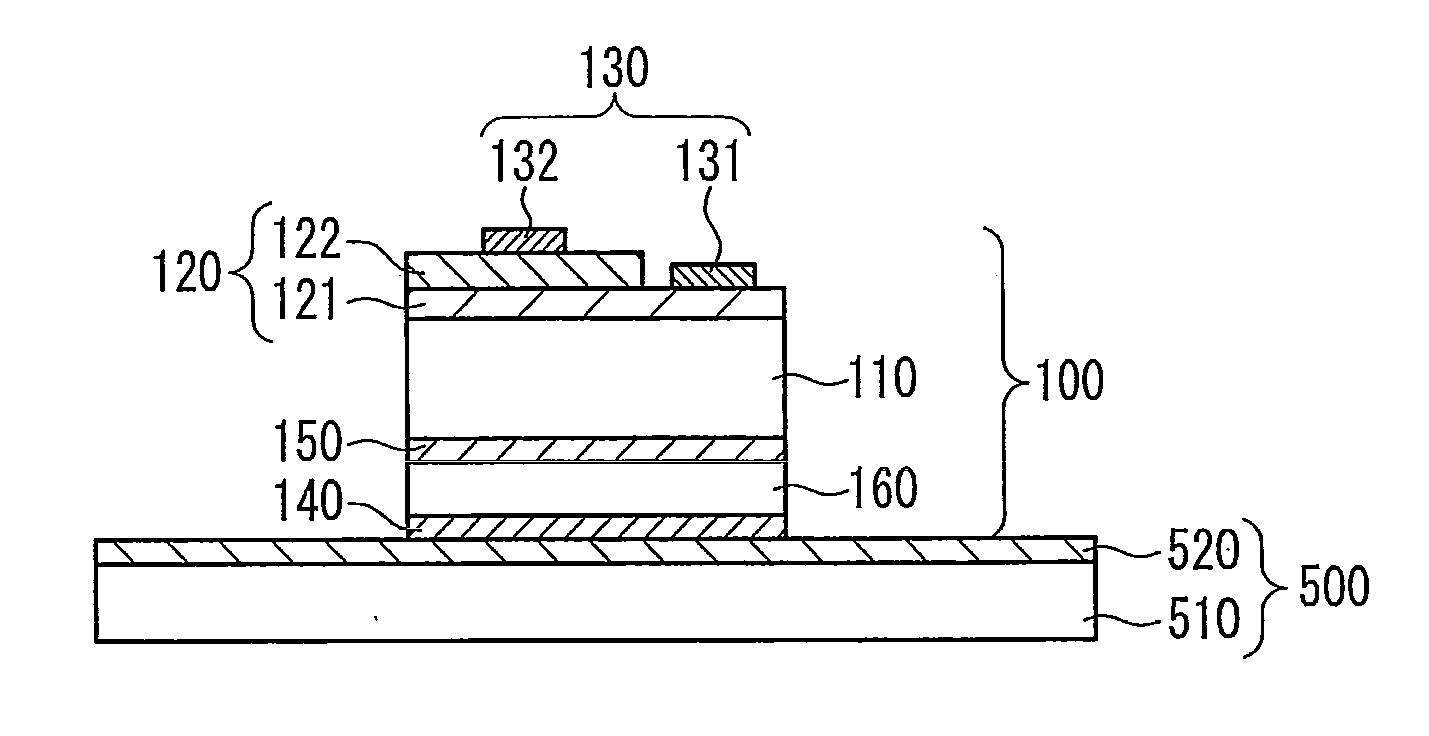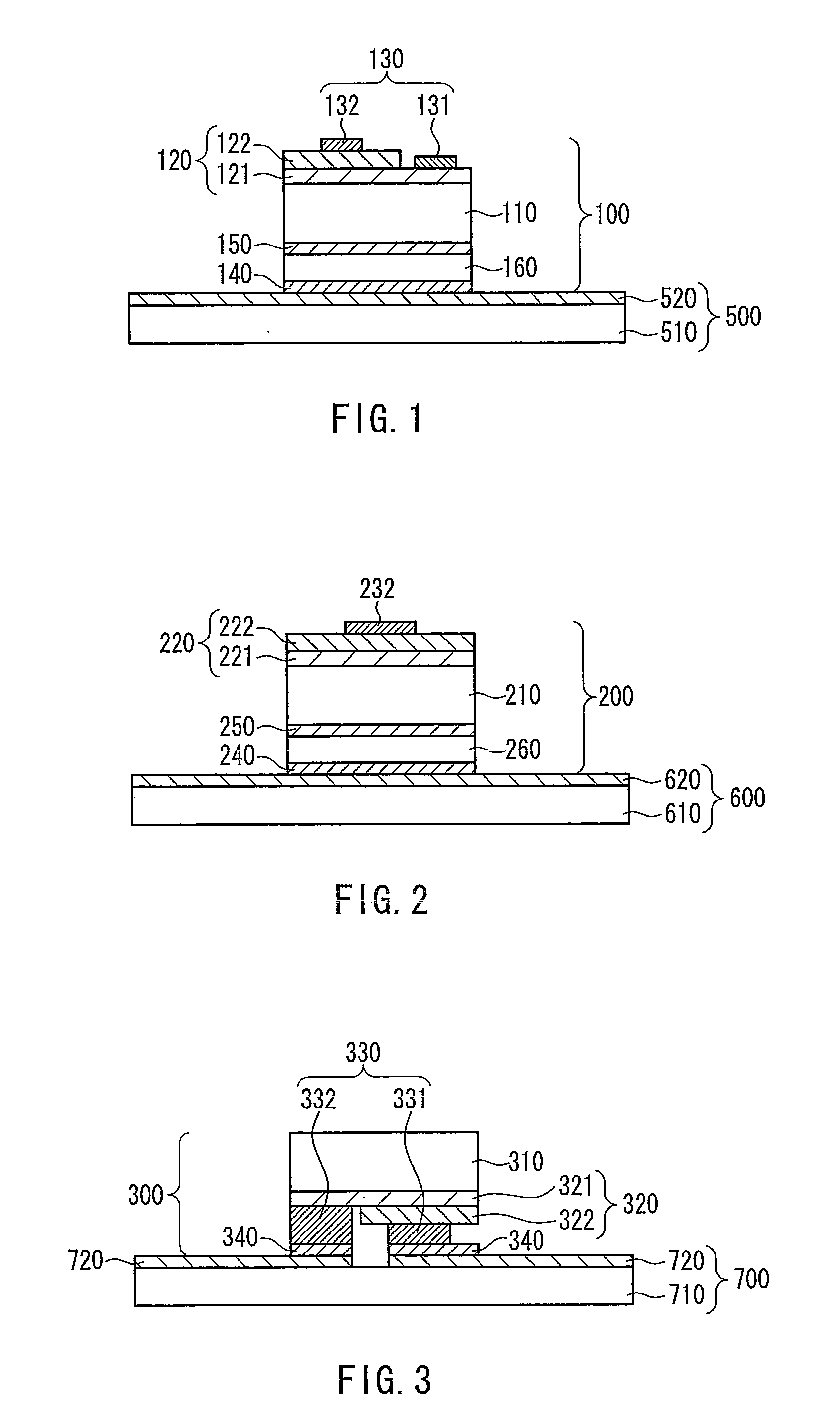Semiconductor device and production method therefor
a production method and semiconductor technology, applied in the direction of semiconductor devices, basic electric elements, electrical appliances, etc., can solve the problems of deterioration of the bonding strength, unilluminable light emitting diodes and the like, and the resin itself that is used in resin bonding to deteriorate, and achieve the effect of simple production method and high heat releasability
- Summary
- Abstract
- Description
- Claims
- Application Information
AI Technical Summary
Benefits of technology
Problems solved by technology
Method used
Image
Examples
first embodiment
Semiconductor Device of the First Embodiment
[0042]An example of the semiconductor device of the first embodiment is described with reference to a drawing. FIG. 1 is a schematic cross-sectional drawing showing the semiconductor light emitting element of the first embodiment when mounted. A description is given with reference to a light emitting semiconductor element that uses a light emitting diode as a semiconductor element, but the present invention is applicable also to transistors, ICs, LSIs, and the like other than light emitting semiconductor elements.
[0043]In the semiconductor device, silver or silver oxide 520 provided on a surface of a base 500 and silver or silver oxide 140 provided on a surface of a light emitting semiconductor element 100 are directly bonded.
[0044]The light emitting semiconductor element 100 includes a translucent inorganic substrate 110, a semiconductor layer 120 that emits light, an electrode 130 disposed on the semiconductor layer 120, first silver 150...
second embodiment
Semiconductor Device of the Second Embodiment
[0057]An example of the semiconductor device of the second embodiment is described with reference to a drawing. FIG. 2 is a schematic cross-sectional drawing showing the semiconductor light emitting element of the second embodiment when mounted. The semiconductor device of the second embodiment has substantially the same configuration as the semiconductor device of the first embodiment except for the light emitting semiconductor element, and some descriptions may be omitted.
[0058]In the semiconductor device, silver or silver oxide 620 provided on a surface of a base 600 and silver or silver oxide 240 provided on a surface of a light emitting semiconductor element 200 are bonded.
[0059]The light emitting semiconductor element 200 includes a translucent inorganic substrate 210, a semiconductor layer 220 that emits light, a p-type electrode 232 disposed on the semiconductor layer 220, first silver 250 provided on the side opposite the side on...
third embodiment
Semiconductor Device of the Third Embodiment
[0062]An example of the semiconductor device of the third embodiment is described with reference to a drawing. FIG. 3 is a schematic cross-sectional drawing showing the semiconductor light emitting element of the third embodiment when mounted. The semiconductor device of the second embodiment have substantially the same configuration as the semiconductor device of the first embodiment except for the light emitting semiconductor element, and some descriptions may be omitted.
[0063]In the semiconductor device, silver or silver oxide 720 provided on a surface of a base 700 and silver or silver oxide 340 provided on a surface of a light emitting semiconductor element 300 are bonded.
[0064]The light emitting semiconductor element 300 includes a translucent inorganic substrate 310, a semiconductor layer 320 that emits light, an electrode 330 disposed on the semiconductor layer 320, and silver or silver oxide 340 provided on the electrode 330. In t...
PUM
 Login to View More
Login to View More Abstract
Description
Claims
Application Information
 Login to View More
Login to View More - R&D
- Intellectual Property
- Life Sciences
- Materials
- Tech Scout
- Unparalleled Data Quality
- Higher Quality Content
- 60% Fewer Hallucinations
Browse by: Latest US Patents, China's latest patents, Technical Efficacy Thesaurus, Application Domain, Technology Topic, Popular Technical Reports.
© 2025 PatSnap. All rights reserved.Legal|Privacy policy|Modern Slavery Act Transparency Statement|Sitemap|About US| Contact US: help@patsnap.com


